Asus ZenBook 13 UX325 review (UX325 – compact 13-inch ultrabook with a big battery)
This here is the compact 13-inch ZenBook 13 UX325JA, the mid-2020 update of the popular Asus ZenBook ultrabook series.
It’s been slightly redesigned from the previous 13-inch ZenBook UX331 and UX333 models, but more importantly, it features updated hardware (Intel IceLake), updated connectivity with Thunderbolt 3 support and USB-C charging, a larger 67 Wh battery, improved screen options, and redesigned inputs. All these in a well-priced package, with the i5 models starting at 900 USD in the US and around 1100 EUR over here in Europe, and the top i7 configurations with 16 GB of memory and 1 TB of storage going for around 1300 EUR.
We’ve spent time with this ZenBook 13 over the last few weeks and gathered our thoughts down below, with the strong points and the quirks that you should consider before buying it.
In just a few words, though, this ZenBook 13 UX325JA is competitive as a compact lightweight laptop for daily multitasking, Office use, and video streaming, but just like its bigger 14-inch brother, it struggles with demanding loads. On top of that, this 13-inch variant gets a more squashed keyboard, the kind those of you with larger hands might have a hard time getting used to, and it still lacks a headphone jack or a touchscreen option.
Specs as reviewed – Asus ZenBook 13 UX325JA
Asus ZenBook 13 UX325JA
Screen
13.3 inch, 1920 x 1080 px, IPS, matte, non-touch
2.5W 300-nits (Chi Mei N133HCE-EN2) or 1W 450-nits panel options
Processor
Intel Ice Lake, up to Core i7-1065G7, 4C/8T
Video
Intel Iris Pro G7, 64EUs
Memory
up to 32 GB LPDDR4X 3200 MHz (soldered)
Storage
1 TB M.2 PCIe x4 SSD (Samsung PM981), Intel Optane H10 variants also available
Connectivity
Wireless 6 (Intel AX201), Bluetooth 5.0
Ports
1x USB-A 3.2 gen1, 2x USB-C 3.2 with Thunderbolt 3(data, video, and power), HDMI 1.4b, microSD card reader, 3.5 mm jack with USB-C adapter
Battery
67 Wh, 65W USB-C charger with quick-charging
Size
304 mm or 11.9” (w) x 203 mm or 7.99” (d) x 13.9 mm or 0.54” (h)
Weight
2.49 lbs (1.13 kg) + .45 lbs (.21 kg) charger, US version
Extras
white backlit keyboard, glass NumberPad, HD+IR webcam with Hello, stereo bottom speakers, optional sleeve, available in Pine Grey and Lilac Mist
Asus offer the UX325 series in a couple of configurations, with various amount of RAM (8-32 GB) and storage (up to 2 TB and Intel Optane), three types of Intel Ice Lake processors (i3-1005G1, i5-1035G1 or i7-1065G7), but also two screen variants, with either a standard 300-nits IPS panel or a more efficient 1W 450-nits option.
Update: In the meantime, our review of the 2022 ZenBook S 13 update is available here, built on the newer Ryzen 7 6800U hardware platform.
Design and construction
This 13-inch UX325 is pretty much a shrunk variant of the 14-inch ZenBook UX425 that we’ve already reviewed, roughly 15 mm shorter, 4 mm narrower, same height, and nearly the same weight (merely 60 grams extra for the 14-inch model). You can barely tell the size difference even when having them side by side, as you can see in these pictures.
Based on these aspects alone, I’d lean towards the 14-inch model with the slightly bigger screen, and that becomes a clear recommendation once you start typing on this 13-inch variant, but we’ll get to that in a bit.
Since the two are nearly identical in every way, I’ll just refer you to the UX425 review for my thoughts on the design language, choice in materials, construction quality, and this laptop’s practicality.
I’ll just mention that Asus did not skimp on the clickpad’s size, the arm-rest, or the IO on this smaller model, aspects sometimes axed on this sort of compact form-factors. At the same time, though, the build quality is still not amazing; despite the nice feeling all-metal construction, this is not a unibody design and the main chassis still creaks and pops when pressing harder on the arm-rest or when lifting the laptop from the desk. In all fairness, though, this ZenBook is not as expensive as many of the other 13-inch ultraportables with similar traits, but those creaks are still difficult to accept and a step back from the previous ZenBook generations.
As for the IO, I’m happy to see two USB-C ports with Thunderbolt 3 support here, HDMI and a full-size USB-A, but I hate the fact that the 3.5 mm jack has been sacrificed. That’s a bold move from Asus, and one I don’t agree with, even if they do include a USB-C to 3.5 mm adapter in the pack. What do you think?
Keyboard and trackpad
The typing experience is what primarily sets this 13-inch ZenBook UX325 apart from its 14-inch kin.
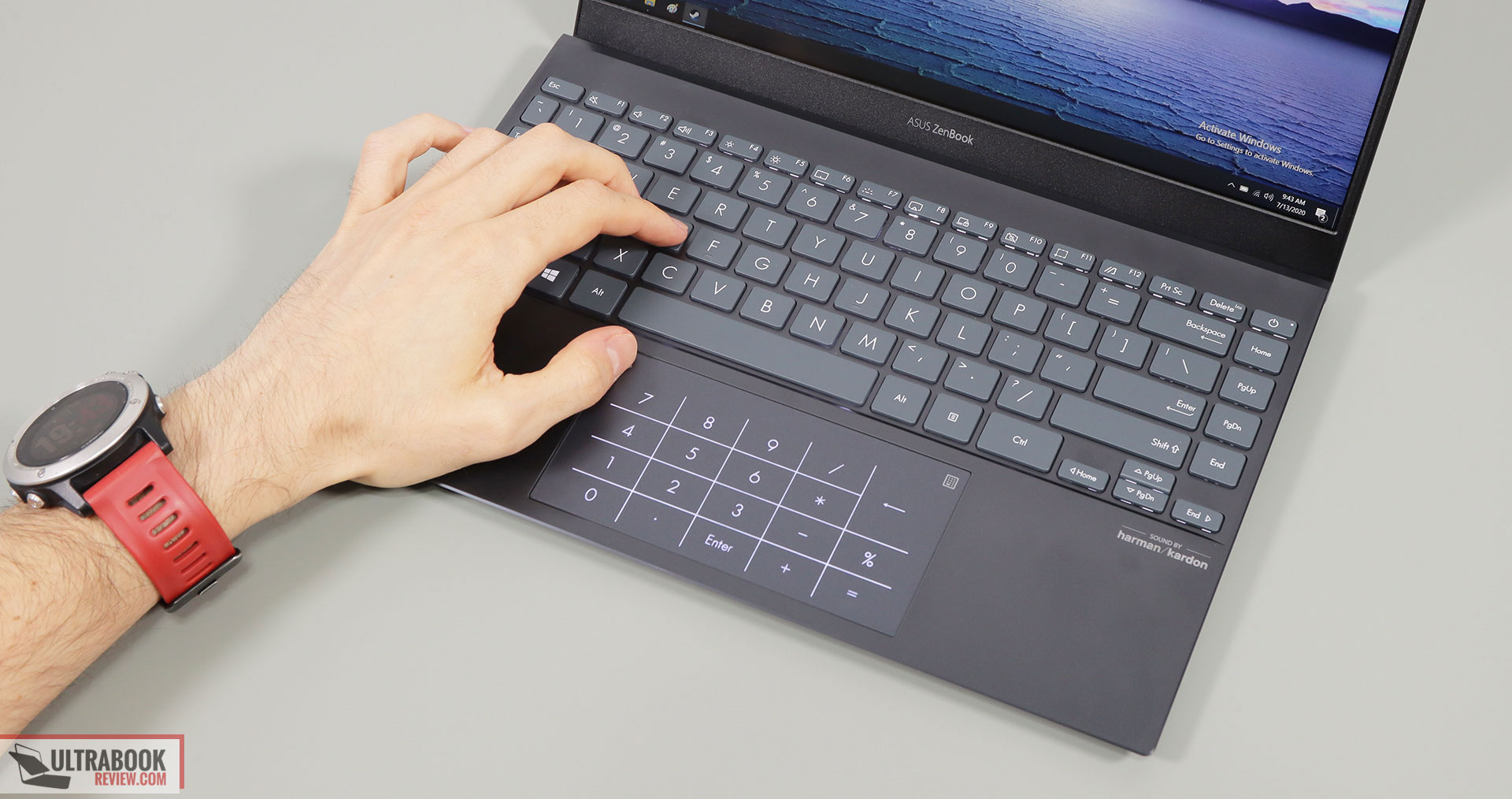
And that’s because the design did not leave room for the same full-size layout implemented in the UX425, but for one with slightly shorter keys. While the UX425 gets a main set of 16 x 15 mm keys, this only gets 16 x 13 mm keys, which cramps up the layout and makes this more prone to missed strokes. In fact, while the UX425 turned out to be one of my favorite Asus keyboards ever experienced, I could not reach the same speed and accuracy results on this 13-inch model, with felt more in line with the average ultrabook.
However, having not tested the UX425 side by side with this 13-inch model, I would have considered this to be a fine keyboard and one that those of you with smaller or averagely-sized hands should still get along alright. But with the UX425 being a superior typer, and including a larger screen at nearly the same size and weight, that would be my first pick, unless the UX325 is significantly cheaper in your region (or if the UX425 is not available over there).
Layout and feedback aside, this keyboard is also backlit, with bright white LEDs and a dedicated Caps Lock indicator. The illumination is even brighter than on the 14-inch model, but not as uniform, at least on this early sample.
Down beneath, centered on the chassis, Asus implemented the same spacious glass clickpad with Precision drivers and secondary NumberPad functionality that’s also in the UX425. It’s a smooth, reliable, and sturdy surface, with good gesture support and palm-rejection.
Some people might complain that this larger surface might be easier to touch with your hand while typing, but that didn’t happen to me on any of these ZenBook versions that I’ve tested. With my typing style, my thumbs mostly float over the clickpad and rarely touch it, and even when they do, the touches were ignored by the palm-rejection technology.
As a side note, there’s no ScreenPad offered for this series. As for biometrics, there’s no finger-sensor on the Zenbook UX325, but you do get an IR camera at the top of the screen.
Screen
Just like on the 14-inch model, Asus offers two screen options for the ZenBook 13 UX325 series. Both are matte non-touch IPS panels with FHD resolution, but one is a standard option with 300-nits of max brightness, and the other is this newer generation and more efficient 1W panel with 450-nits of maximum brightness.
Our test unit gets the standard panel, and even this one is good enough for daily use, with almost 100% sRGB color coverage, wide viewing angles, and slightly better brightness and contrast than the 14-inch variants we’ve tested.
Here’s what we got in our tests, with an X-Rite i1 Display Pro sensor:
- Panel HardwareID: Chi Mei CMN1388 (N133HCE-EN2 CMN);
- Coverage: 97.9% sRGB, 68.2% NTSC, 70.5% AdobeRGB;
- Measured gamma: 2.10;
- Max brightness in the middle of the screen: 336.69 cd/m2 on power;
- Min brightness in the middle of the screen: 20.35 cd/m2 on power;
- Contrast at max brightness: 1322:1;
- White point: 7200 K;
- Black on max brightness: 0.25 cd/m2;
- PWM: No.
This needs calibration to fix the skewed Gamma and blue White point. Once calibrated, though, I’m seeing small amounts of light bleeding and almost no color or luminosity uniformity issues.
I’ll update this section when/if we get to also test the 1W screen as well.
Hardware and performance
Our test model is a top-specced configuration of the Asus ZenBook 13 UX325JA, with an Intel Core i7-1065G7 processor and Intel Iris Pro graphics, 16 GB of LPDDR4x 3200 MHz memory and a fast 1 TB Samsung SSD.
Before we proceed, keep in mind that our sample was sent over by Asus and was tested with the software available as of early-July 2020 (BIOS 206, MyAsus 2.2.22.0 app).
Specs-wise, this is identical to the ZenBook 14 UX425JA already reviewed, with the same Intel Ice Lake processor, type of RAM, and storage. Everything is soldered on the motherboard, except for the SSD. Getting inside requires removing the back panel, which is held in place by a couple of visible Torx screws, as well as two extra Philips screws hidden behind the rear rubber feet.
Just like with the 14-inch model, the SSD is placed right next to the CPU and heats-up to middling temperatures with daily use, mid-50s with gaming, and mid-60s with storage tests.
As far as the software goes, this gets the standard MyAsus app which allows control over the power profiles, battery and screen settings, updates, etc, while the Audio is controlled in AudioWizard.
There are two performance/thermal profiles to choose from:
- Dynamic – allows the CPU to run at 15+W, with fans ramping up to 40 dB in demanding loads and games;
- Whisper – limits the CPU to favor lower fan-noise.
I just kept the laptop in Dynamic, it’s a well-balanced profile that keeps the fan idle with light use, and quiet with heavier loads. The laptop also feels snappy with daily multitasking, video streaming, Office use, and the likes.
Just like with the 14-inch variant, this ZenBook UX325 struggles with demanding loads, due to the applied power limits and a fan profile that favors lower noise.
We start by testing the CPU’s performance in taxing chores by running the Cinebench R15 benchmark for 15+ times in a loop, with 2-3 seconds delay between each run, on the Dynamic mode.
The IceLake i7 processor runs at higher clocks and power for the first 1-2 loop, but then quickly drops and stabilizes at around 20W of power and 2300 MHz, with temperatures in the low to mid-80s Celsius. The fan ramps to about 38-39 dB at head-level in this test, and the laptop returns scores of around 580 points.
We also ran the same test with the laptop unplugged, and in this case, the CPU stabilizes at around 15W and lower scores.
Normally the performance of these Intel Core U chips can be improved with a slight undervolt, possible with the latest variants of Throttlestop, however, undervolting was somehow disabled on all our samples and we could not tweak the settings in any way.
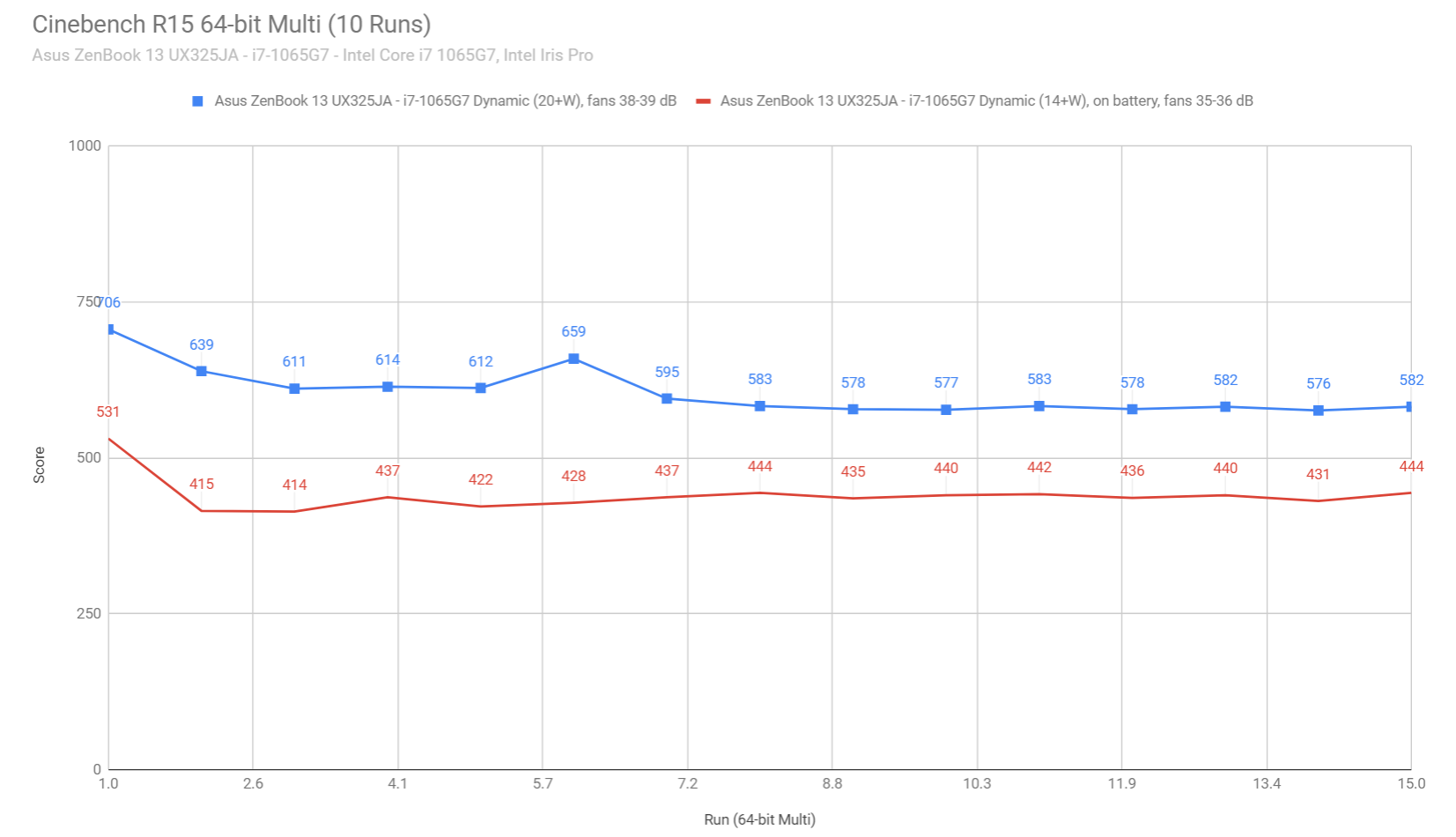
To put these results in perspective, here’s how a couple of other AMD and Intel ultraportable notebooks score in this same test.
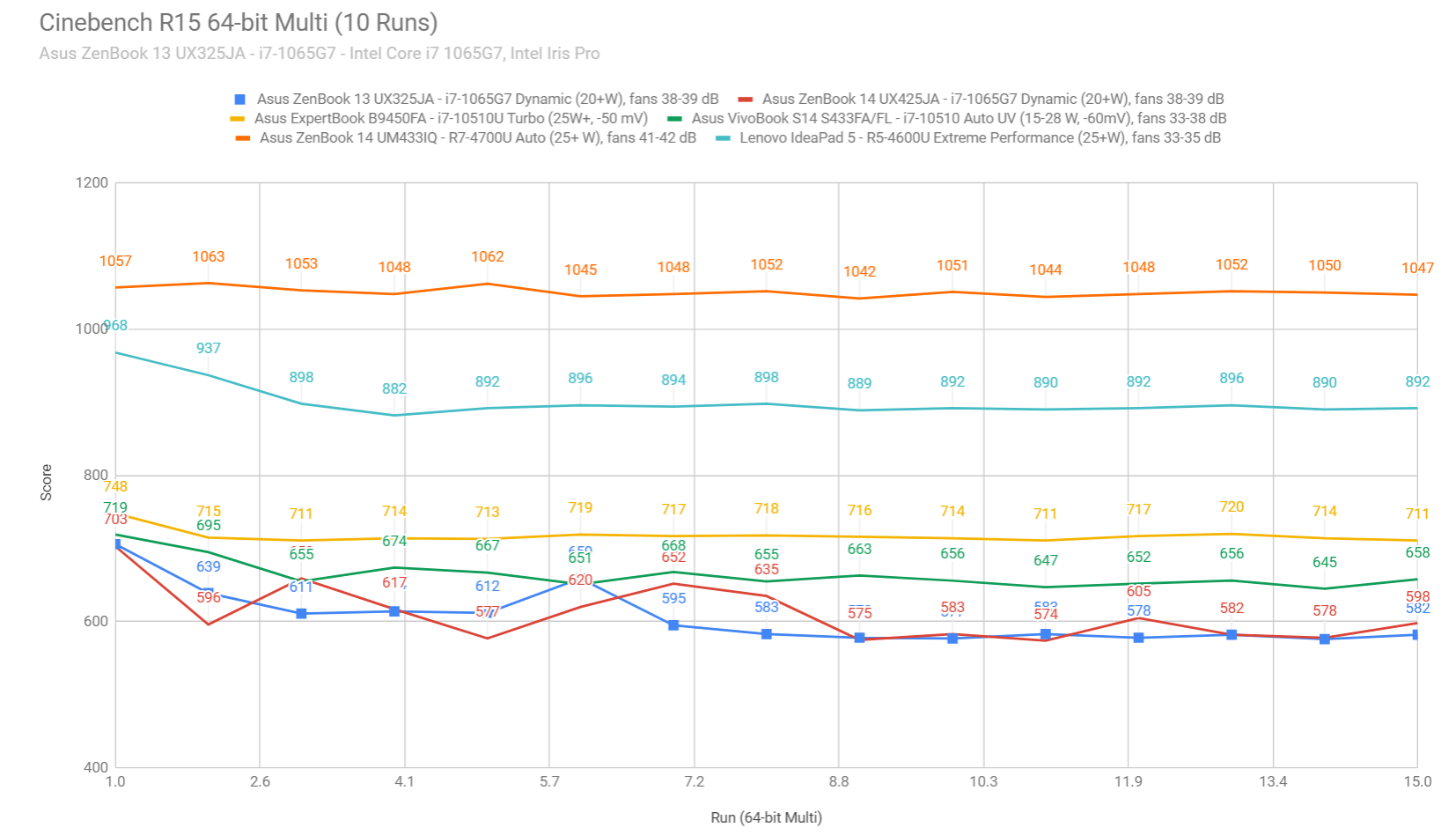
Running the longer and more challenging Cinebench R20 test causes the CPU to stabilize at 14-15W, with temperatures in the high-60s, and the same happens when running the gruesome Prime 95 test.
We also ran our combined CPU+GPU stress tests on this notebook, on the same Dynamic profile.
3DMark stress runs the same test for 20 times in a loop and looks for performance variation and degradation over time, and this unit did not pass it. Luxmark 3.1 fully loads both the CPU and GPU at the same time. On this notebook, the CPU package runs at high power for the first minute or two, but also fairly high temperatures in the mid-80s, and then drops and stabilizes at around 13W, with greatly limited CPU and GPU frequencies.
That’s what you should generally expect from this notebook: snappy performance with daily use and short taxing loads, but a significant decrease in performance in complex tasks that take more than a minute to perform. That’s why this should do fine for editing photos, but not for editing videos or most other taxing work/school applications.
Next, we ran the entire suite of tests and benchmarks on the standard Dynamic profile. Here’s what we got, but keep in mind these are best effort scores, and this ZenBook UX325 cannot sustain these results for long.
- 3DMark 13 – Fire Strike: 2184 (Graphics – 2482, Physics – 7712, Combined – 735);
- 3DMark 13 – Night Raid: 8221 (Graphics – 9506, CPU – 4657);
- 3DMark 13 – Time Spy: 743 (Graphics – 662, CPU – 2469);
- AIDA64 Memory test: Write: Read: 46551 MB/s, Read: 44860 MB/s, Latency: 93.3;
- Uniengine Superposition – 1080p Medium: 1514;
- Handbrake 1.3.1 (4K to 1080p encode): –15.18 average fps;
- PassMark: Rating: 4441 (CPU mark: 10114, 3D Graphics Mark: 2056, Disk Mark: 17402);
- PCMark 10: 4264 (Essentials – 9056 , Productivity – 6827 , Digital Content Creation – 3404);
- GeekBench 4.4.2 64-bit: Single-Core: 5678, Multi-core: 17979;
- GeekBench 5.0.1 64-bit: Single-Core: 1306, Multi-core: 4399;
- CineBench R15 (best run): CPU 706 cb, CPU Single Core 182 cb;
- CineBench R20 (best run): CPU 1370 cb, CPU Single Core 435 cb;
- x264 HD Benchmark 4.0 32-bit: Pass 1 – 156.12 fps, Pass 2 – 32.76 fps;
- x265 HD Benchmark 64-bit: 113.54 s.
We also ran some Workstation related loads, on the same Dynamic profile:
- Blender 2.82 – BMW Car scene- CPU Compute: 12m 26s (Auto);
- Blender 2.82 – Classroom scene – CPU Compute: 40m 38s (Auto);
- Luxmark 3.1 – Luxball HDR – OpenCL CPUs + GPUs score: 3900;
These are not bad results for an Ice Lake implementation, and down below you can see how this ZenBook 13 fares against the ZenBook 14 and some of the other similar ultrabooks we’ve tested.
Finally, we ran a couple of DX11, DX12, and Vulkan titles on the Dynamic Best Performance profile and Low/Lowest graphics settings. Here’s what we got:
UX325 – Intel i7 + Iris Pro
UX425 – Intel i7 + Iris Pro
UM433 – Ryzen 7 + MX350
UX434 – Intel i7 + MX250
Bioshock Infinite (DX 11, Low Preset)
33 fps (18 fps – 1% low)
40 fps (22 fps – 1% low)
97 fps (45 fps – 1% low)
76 fps (39 fps – 1% low)
Dota 2 (DX 11, Best Looking Preset)
18 fps (12 fps – 1% low)
34 fps (20 fps – 1% low)
74 fps (39 fps – 1% low)
47 fps (20 fps – 1% low)
Far Cry 5 (DX 11, Low Preset, no AA)
12 fps (10 fps – 1% low)
12 fps (10 fps – 1% low)
35 fps (32 fps – 1% low)
25 fps (21 fps – 1% low)
Middle Earth: Shadow of Mordor (DX 11, Lowest Preset)
28 fps (20 fps – 1% low)
32 fps (22 fps – 1% low)
65 fps (48 fps – 1% low)
31 fps (18 fps – 1% low)
Need for Speed: Most Wanted (DX 11, Lowest Preset)
44 fps (22 fps – 1% low)
42 fps (25 fps – 1% low)
–
–
Rise of the Tomb Raider (DX 12, Lowest Preset, no AA)
14 fps (2 fps – 1% low)
16 fps (3 fps – 1% low)
45 fps
39 fps
Shadow of Tomb Raider (Vulkan, Lowest Preset, no AA)
11 fps (2 fps – 1% low)
17 fps (12 fps – 1% low)
40 fps (35 fps – 1% low)
29 fps (25 fps – 1% low)
Strange Brigade (Vulkan, Low Preset)
21 fps (3 fps – 1% low)
21 fps (7 fps – 1% low)
44 fps
35 fps
The Witcher 3: Wild Hunt (DX 11, Low Preset, Hairworks Off)
–
–
29 fps avg (18 fps – 1% low)
24 fps avg (10 fps – 1% low)
- Battlefield V, The Witcher 3, Dota 2 – recorded with MSI Afterburner in game mode;
- Bioshock Far Cry 5, Middle Earth, Strange Brigade, Red Dead Redemption 2, Tomb Raider games – recorded with the included Benchmark utilities;
Casual games such as Minecraft and Dota2, or older titles such as Bioshock or Need for Speed: Most Wanted run at FHD 30+ fps on this laptop, but even with these titles we’re looking at a loss in performance after a couple of minutes of gaming, when the CPU ends up running at ~1 GHz, with the GPU running at 600 MHz, both significantly throttled from their maximum potential frequencies. Overall, the performance is slightly more limited than on the 14-inch model, although none of these excel here in any way.
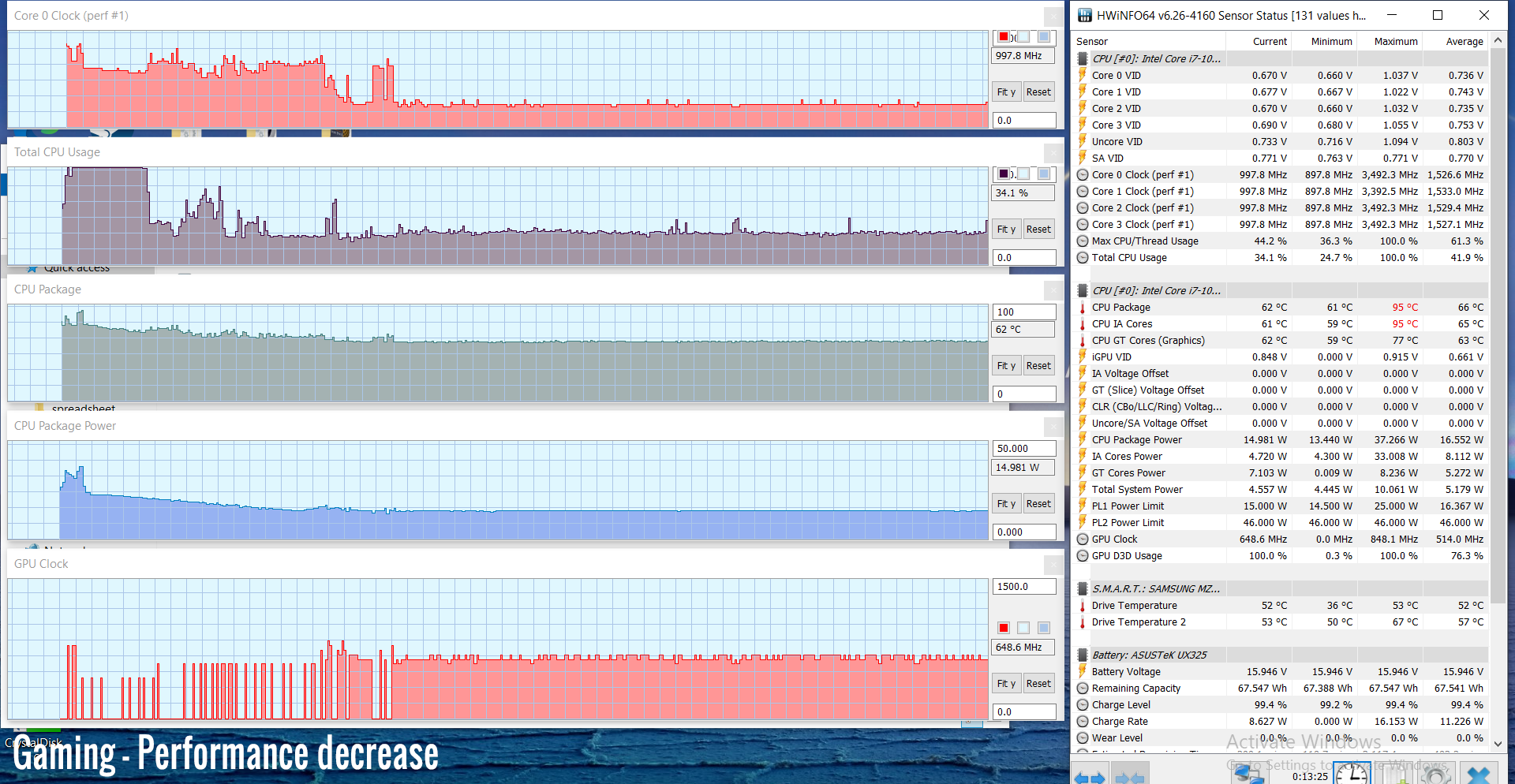
Once more, don’t forget that our sample is pre-release and this behavior might improve with the final retail products. I’ve asked Asus for one of those so I can rerun these tests and update the article once the ZenBook 13 UX325 gets in stores over here.
Just like with the 14-inch model, though, I wouldn’t expect significant changes. Improved performance would require a higher power envelope of around 25W, and I don’t think this chassis can handle that long-term, even with a faster spinning and noisier fan.
Noise, Heat, Connectivity, speakers, and others
Asus went with a basic thermal module here, with a single heatpipe and single fan, the same kind we’ve seen in the 14-inch ZenBook UX425, and most of their portable lineups launched in recent years.
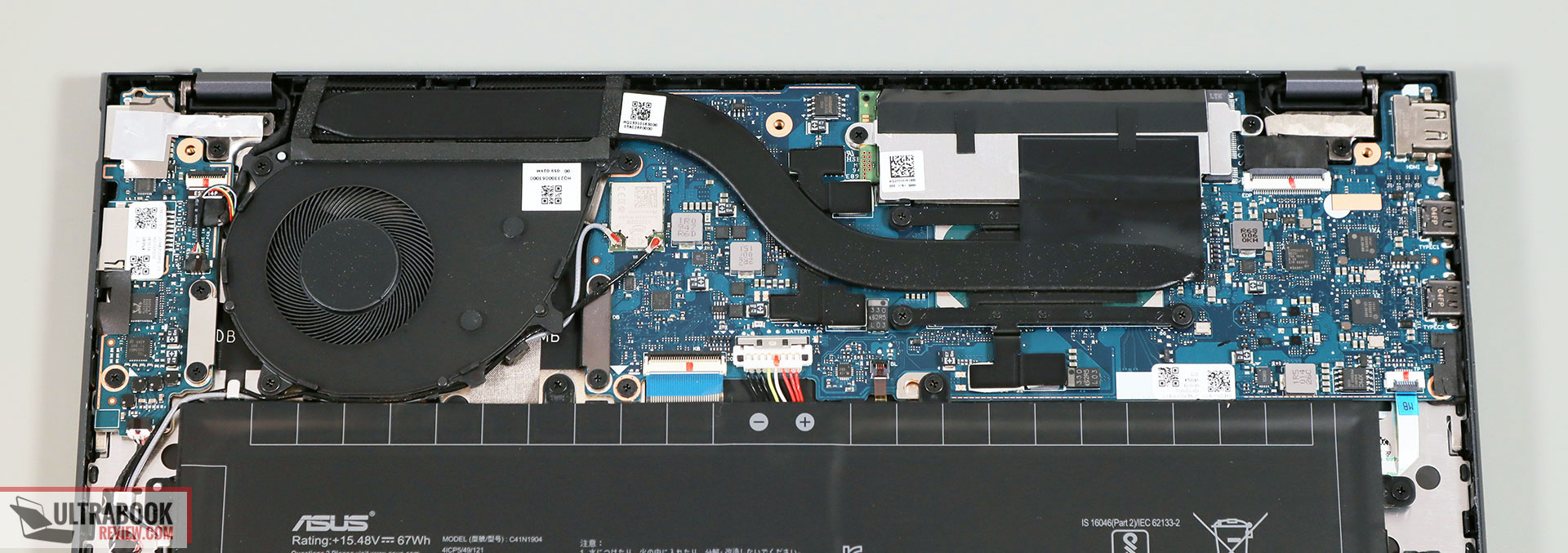
The software is also designed to minimize fan-noise, and not to favor performance. As a result, the fan rests idle most of the time with daily use and only ramps up to 39-40 dB at head-level when running games and other combined CPU+GPU loads.
Internal temperatures are kept at bay, but that’s primarily because the hardware package is power-limited in taxing loads, with the toll in performance mentioned earlier.
As it is, our Zephyrus 13 UX325 sample ran warm with daily use (but remember that’s with mostly passive cooling), and averagely hot with taxing loads. We measured temperatures in the mid-40s on the keyboard deck and high-40s on the bottom, but also high-40s on the screen’s chin, right next to the exhaust. However, that thicker chin takes most of the exhausting heat and the actual panel doesn’t run as hot as on the previous ZenBook lineups.
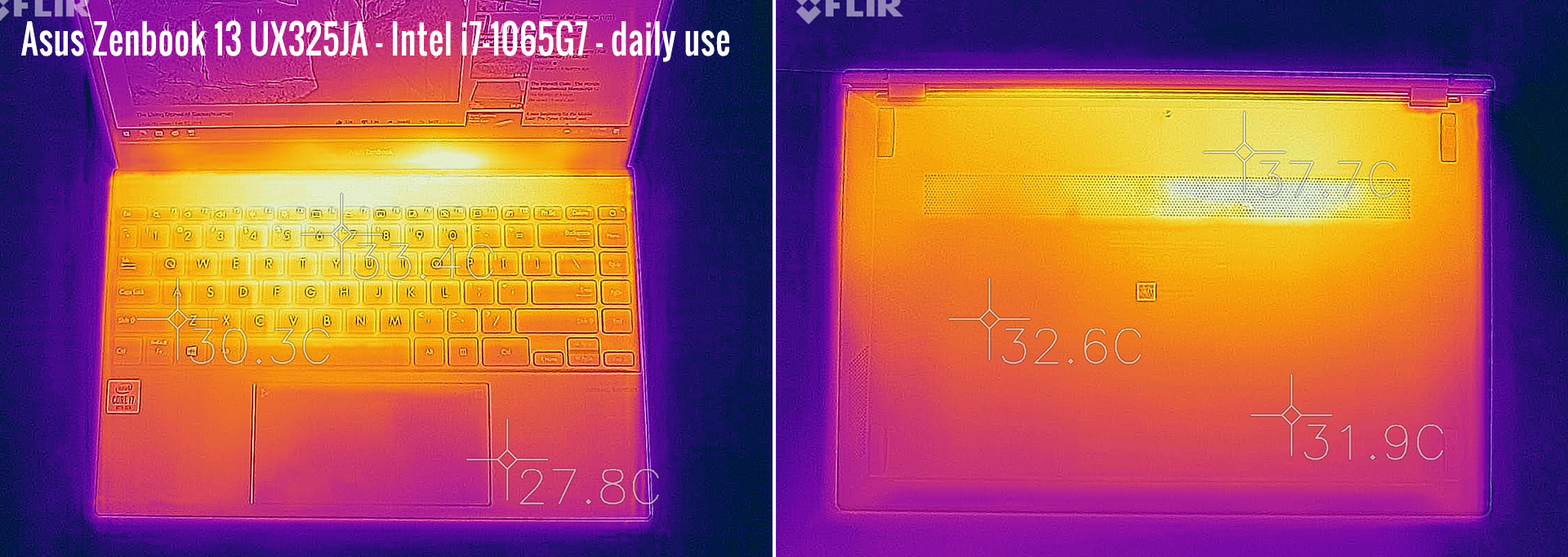

*Daily Use – streaming Netflix in EDGE for 30 minutes, Quiet Mode, fans at 0-35 dB
*Gaming – Extreme Performance mode – playing Far Cry 5 for 30 minutes, fans at 39-40 dB
For connectivity, there’s latest-gen WiFi 6 with an Intel AX201 module on this laptop. It performed very well with our setup, both near the router and at 30+ feet.
Audio is handled by a set of stereo speakers that fire through grills on the underside. The angled shape of the D-panel allows the sound to bounce off the table without distortions, also ensuring they won’t be easily covered while using the laptop on the lap. I haven’t noticed any vibrations in the arm-rest at higher volumes, either.
However, just like on the 14-inch model, these don’t get very loud. We measured volumes of 70-72 dB at head-level in our tests, with about average sound quality on the Music profile in Audio Wizzard.
As for that HD camera placed at the top of the screen, it’s fine for occasional calls, but not much in terms of quality.
Battery life
There’s a 67 Wh battery inside the ZenBook 13 UX325, significantly larger than what you’d normally get in a 13-inch notebook. With the efficient Intel hardware implementation and screen, this notebook should last for a fair while on a charge.
Here’s what we got, with the screen’s brightness set at around 120 nits (~60 brightness). Don’t forget that our unit gets the standard 300-nits panel and not the more efficient 1W option.
- 9 W (~7+ h of use) – text editing in Google Drive, Dynamic + Better Battery Mode, screen at 60%, Wi-Fi ON;
- 7.6 W (~9- h of use) – 1080p fullscreen video on Youtube in Edge, Dynamic + Better Battery Mode, screen at 60%, Wi-Fi ON;
- 6.5 W (~10+ h of use) – Netflix fullscreen in Edge, Dynamic + Better Battery Mode, screen at 60%, Wi-Fi ON;
- 12 W (~5-6 h of use) – browsing in Edge, Dynamic + Better Performance Mode, screen at 60%, Wi-Fi ON.
That 1W display is supposed to shave off about 1.25W of power at 150-nits of brightness, so will improve the runtimes. Looking forward to testing it as well.
The laptop comes with a compact 65W charger that plugs-in via USB-C. It’s a single-piece design with a compact brick and a long and thick cable, and a full charge takes about 2 hours. However, quick-charging allows to fill-up to 60% in less than an hour.

Price and availability
The ZenBook 13 UX325 is available in stores around the world.
Right now, it starts at 1100 EUR in Germany or 899 GBP in the UK for the i5 model with 8 GB of RAM, 512 GB of storage, and the 1W 450-nits screen. The same configuration, but with the i7 processor, is listed at $899 in the US, with the i5 model starting at $799, which ar both great prices for these laptops.
We’ll update when we know more, and in the meantime, follow this link for updated prices and configurations in your region.
Final thoughts
As mentioned already in the article, the shrunk keyboard is what primarily sets this ZenBook 13 UX325 apart from the marginally larger 14-inch UX425 version. That’s still fine for those of you with smaller hands, but the UX425 is a more reliable and more accurate typer.
With that out of the way, both these laptops are fairly well made and lightweight, offer good screen options, decent IO, and larger batteries than most other options in their niches, with very few exceptions such as the LG Grams. At the same time, these struggle with demanding loads, so unless you plan to only use them for everyday multitasking, browsing, office apps, and video/music streaming, I’d look into something more powerful, perhaps one of those competent Ryzen 4000 notebooks or even beefier implementations of the Intel Core U hardware. Asus also plan to offer a Ryzen 4000 variant of the 14-inch model (the ZenBook UM425) shortly, but I haven’t yet heard of a similar 13-inch variant.
From the looks of it, though, this 13-inch ZenBook might be more widespread and slightly more affordable than the 14-inch model, and that alone would just make it the better buy for some of you. However, if the two sizes are available for the same kind of money in your region, I’d surely opt for the UX425 model.
With that in mind we’ll wrap up this article here, but I’d love to hear your thoughts on this Asus ZenBook 13 UX325JA, so get in touch down below with your feedback or any questions that I could help with.
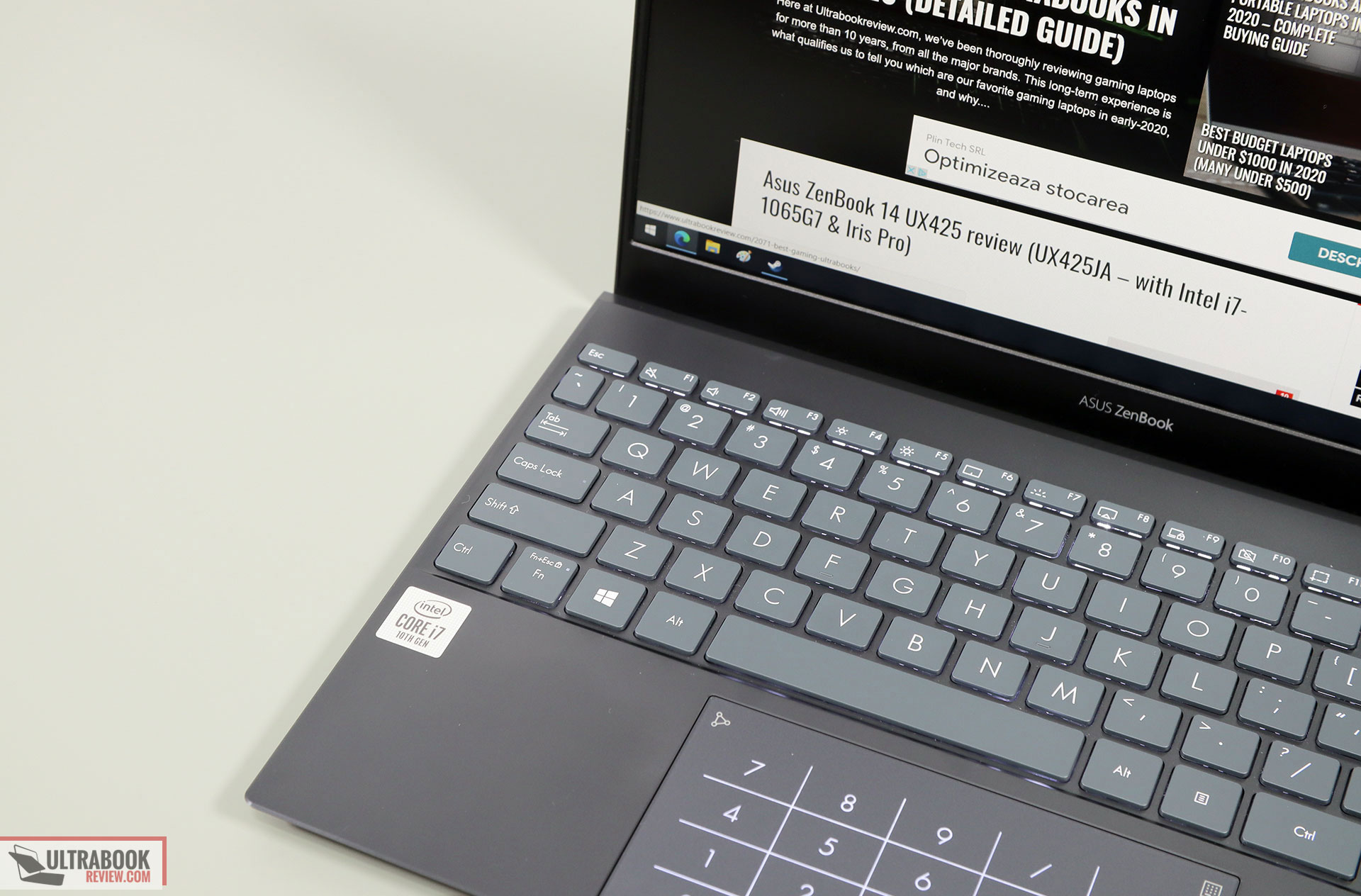
Disclaimer: Our content is reader-supported. If you buy through some of the links on our site, we may earn a commission.
Navigation: Ultrabookreview.com » 13 inch
Our content is reader-supported. If you buy through some of the links on our site, we may earn a commission. Terms


Review by: Andrei Girbea
Andrei Girbea, Editor-in-Chief. I’ve a Bachelor’s in Computer Engineering and I’ve been covering mobile technology since the 2000s. You’ll mostly find reviews and thorough guides written by me here on the site, as well as some occasional first-impression articles.
. I’ve a Bachelor’s in Computer Engineering and I’ve been covering mobile technology since the 2000s. You’ll mostly find reviews and thorough guides written by me here on the site, as well as some occasional first-impression articles.






